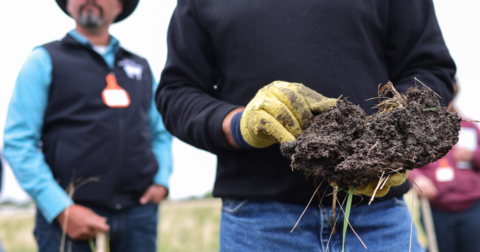News
Could Genetically Engineered Fungus Help Replace Animal Protein?
Breakthroughs•5 min read
Feature
The tradeoffs — better soil health, lower yields — come with steep consequences for climate change.


Words by Dawn Attride
Farmers are increasingly turning to regenerative agriculture — a trendy method of farming that originates from global Indigenous land practices. The core concept of regenerative farming is implementing a range of nature-based practices like cover cropping and not tilling the soil. Companies like Cargill and Nestle have jumped on the bandwagon and in 2024, the Biden Administration invested $5.7 billion in “climate-smart” strategies, including many regenerative agriculture practices. But a new study from researchers at New York University and Cornell challenges some of those assumptions, finding that previous estimates of climate potential might be overstated and that regenerative agriculture could lead to significantly lower crop yields.
Using a global modelling scenario through the year 2100, the researchers evaluated the various outcomes of certain regenerative practices, including not tilling the soil, leaving crop residues on land and planting grass and legume cover crops.
Planting grass cover crops in combination with no tillage was the best at stopping carbon release, keeping roughly 900 million tons of carbon dioxide out of the atmosphere annually, according to the findings. But that came with a catch of lowering crop yields by an estimated 140 million tons through 2050. For planting legume cover crops, the opposite was true — they typically resulted in higher crop yields but had less of a carbon reduction benefit.
All in all, they found that even if somehow these practices were immediately adopted 100 percent of the time, the max benefit would only reduce global emissions by about 1 percent annually.
This finding goes against the grain of regenerative agriculture as a front-running climate solution, as recently hailed in the award-winning documentary “Common Ground.” In the film, celebrities and farmers explored ways to change our food system.
“These regenerative practices on croplands are important, but they’re not the key. They’re not the silver bullet or panacea climate strategy,” Shelby McClelland, lead author on the paper and post doctoral researcher at the Department of Environmental Studies at New York University, tells Sentient. She stresses the importance of investing in other strategies in tandem with regenerative practices to see the best return on climate investment.
“We agree with the conclusions that were found in the paper that cover crops and no till, whether applied in single or combination, are not going to be a significant climate mitigation lever. The point of cover crops and no till is more for soil security, rather than climate mitigation, and that should be the primary reason to invest in them,” Mike Badzmierowski, at the World Resources Institute, who was not involved in the study, tells Sentient.
Compared to other more effective climate solutions like reducing red meat consumption and proper manure management, it’s clear that regenerative farming isn’t going to be the saving grace for reducing agriculture’s high emissions, he says.
Roughly a third of all global emissions come from food systems. In the past, farm operations have expanded exponentially in order to feed a growing global population.
Even if the way people around the world eat stays roughly the same, our planet’s growing global population will create a “substantial increase” in global food needs through 2050, according to the U.S. Department of Agriculture. The number of people on the planet is expected to hit nearly 10 billion people by 2050 — and at the same time, we’re running out of the kind of land we can convert to farms.
How we use land unlocks crucial opportunities to mitigate climate pollution. Continuing to expand farm production will be a disaster for the planet — more deforestation and greenhouse gas emissions at a time when the world is already on track to hit between 1.9 and 3.7 degrees of global warming by 2100.
If the findings of this predictive model hold true and regenerative practices reduce crop yields in certain regions, it likely won’t be a sustainable solution. Lower crop yields require more land to produce the same amount of food, which drives deforestation and, in turn, global climate pollution. Given these challenges, the researchers say the work will help farmers prioritize the best management practices for their land.
The results of using regenerative farming varied by country, with Latin America and Caribbean countries having the highest climate and crop yield gains from these strategies. That’s mainly because food systems in the Global South can be nitrogen limited, so planting a legume will likely increase soil nitrogen availability, McClelland says.
Predictive models like those employed in the NYU study are limited by the quality of the data they use. According to Timothy Searchinger, senior research scholar at Princeton’s Center for Policy Research on Energy and the Environment, the data is especially challenging for regenerative agriculture studies, because there are still “enormous uncertainties” in soil carbon modelling. Searchinger, who was not involved in the paper, told Sentient in an email, “I think the only responsible view right now is that we don’t really know the effect of cover crops on net emissions. I suspect they do build some soil carbon – or at least reduce losses – but we don’t know by how much.”
Although proponents of regenerative agriculture continue to put forward these practices as a multifaceted solution for tackling climate change and increasing food system resilience, this research suggests there are serious limitations in food production that need to be addressed.
However, McClelland stresses that many regenerative farming practices are still important, particularly for soil health, even as she cautions against platforming them as a leading environmental solution. “Regenerative cropping practices have a role to play in our climate portfolio of actions. I just think we need to be keeping in mind the magnitude of potential there.”